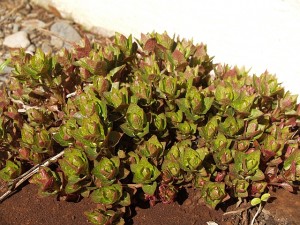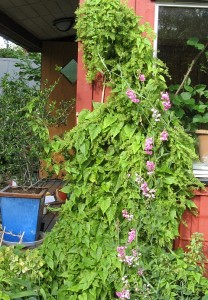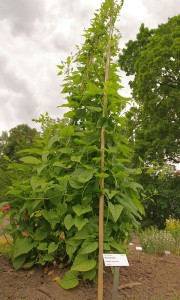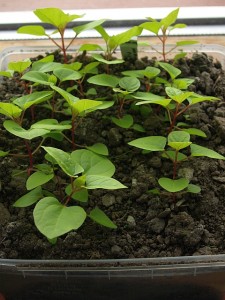My article “Caucasian spinach: the unknown woodlander” was published by Permaculture Magazine 9 years ago in 2007 (see http://www.edimentals.com/blog/?page_id=1984 and also my book Around the World in 80 plants). In the meantime this vegetable has become a popular perennial vegetable and forest garden plant grown by thousands around the world, and is perhaps the first new vegetable to become popular thanks to social media and the permaculture movement! At last the results of a project to analyse the nutrient content of this plant have been announced on our Friends of Hablitzia FB group by Leena Nurmi who carried out the work for her masters thesis in Finland! And the news is very good, confirming that Hablitzia (Caucasian Spinach) is not only a fantastic productive perennial vegetable but also is superior to spinach and New Zealand spinach nutritionally and for those who worry about oxalic acid and nitrates, both are within accepted limits!!
Time for a celebration ![]()
She writes: “Hello Stephen and other Hablitzia friends! Greetings from Finland. I have done my master’s thesis about Hablitzia “Hablitzia tamnoides – a new but old leafy vegetable of early summer: cold stratification of seeds and nutritional value of leaves”. Now I am writing a scientific article about the nutritional value of Hablitzia. Caucasian spinach contains particularly plenty of carotenoids, folates, calcium, magnesium, phosphorus and zinc. Also many other nutritions were larger in Hablitzia than in spinach and New Zealand spianch. In my study the oxalic acid, nitrate, cadmium and lead contents did not outweigh the permissible threshold values. The seeds of Hablitzia need to be stratified either in a cold room or outside during winter in order to germinate. The highest germination rate was 52 %, recorded from the Tampere population stratified at +5 ºC in a cold room. The seeds of Tampere population were picked up in February and sown for stratification in the middle of March. In Finland Hablitzia grows even in Oulu, but wetness of soil kills the plant very easily.”





Is there the study of Leena Nurmi available on-line?
She replied that it’s still not available as her supervisor has been too busy :(
Thanks for this article!! Good to know that Hablitzia has arrived in Czech!!
Stephen
Yes, it has arrived two years ago into our family seed farm. I was really suprised how well it grows here and that nobody knows nor grows this amazing plant. It has no name in my language so I gave it name “šplazát” which consists of “ŠPenát” meaning “spinach” and “PLAZivý” meaning “climbing” or “creeping”. Now it starts to spread to hundreds of gardens here as I have enough seeds to sell to other people. Thanks for letting me know about this plant, Stephen.
Hello,
I am trying to find out nutritional information for Hablitzia tamnoides for a research project for my degree. If anyone has any information or links that may help, please feel free to email me.
Thanks,
Harriet
Hi Harriet!
I would suggest you try to contact Leena Nurmi on Facebook. I don’t seem to have her email!
If you don’t succeed let me know!
I’d also love to hear more of your project!
Stephen
Hi There,
May I ask how long hablitzia seeds need to be stratified, at minimum, in order to germinate?
10 days in a fridge or outside if it’s cold is usually enough!
2 months in moist paper towel in ziplock bag in freezer
I’m very intriguet by this plant species. And was looking for growing conditions and then for a seeds.
To add my 20 cents.
I found it is a red listed species growing on mountain areas (200-1500m) including chalk cliffs, fagus sylvaticus woods, near rocks, in mountain valleys and in riverine growth (use google translate):
https://mpr26.ru/okhota/krasnaya-kniga/plants/p_105.html
Photos in it’s natural enviroment:
https://www.plantarium.ru/page/view/item/17956.html
Not mutch information is aviable, probably becouse of rarity in enviroment or well hidden growth conditions. At least there is no ethnobotanic information.
Thanks for those links which have been updated since I last saw them.
Shame that there still isn’t any ethnobotanical information from the source region, perhaps due to its rarity.
I’ll share with my Friends of Hablitzia group on Facebook where you can find a lot more information in the files section and also reports from those that have found it in the wild.
I downloaded book “Flora of Caucasus” of 1910. It mentions Hablicia in just a few sentences, that it have ornamental value and should be planted in parks.
* * *
The “Red book” of Chechenia says (translated):
Family. CHENOPODIACEAE – Hablitzia tamnoides Bieb. – Gablicia tamus-like. Caucasian forest monotypic genus
Herbaceous perennial with climbing vine stem reaching a length of 100 to 200 cm. Leaves elongated ovate-cordate, entire, on long petioles, with pinnate venation. flowers in axillary and terminal semi-umbrellas, bearing 3 at flower garden. The common inflorescence is a panicle.
Ecology. Grows in shady broad-leaved forests among rocks and on screes, along the edges, forests margins in humus rich soils in the lower mountain forest belt. Prefares carbonate rocks (limestones, dolomites).
Distribution. North Caucasus (Kabardino-Balkariya, North Ossetia, Ingushetia, Stavropol Territory, Chechnya, Dagestan). In Chechnya and Ingushetia – in the Targim basin, along the river Asse, Fortange (neighborhood of Alkun), in 64 Aksai river basin (v. Belgatoy, Dargo).
The state of the population. In the territory of the Chechen Republic it is a very rare species, found singly, scattered. Stocks are very limited.
Natural renewal. Seed.
Reasons for population decline. felling of beech forests, road construction in the mountains.
Recommendations. Habitat protection, seed sowing, growing in botanical gardens. A detailed study of the ditribution area of species on the territory of the republic. Decorative.
Scientific and practical value. Of interest as a representative of the Caucasian forest monotypic genus. Decorative as an ampelous plant (hanging pots).
Sources of information. 1. Galushko, 1978. 2. Plant life, vol. 5 (1), 1980. 3. Red Book of RSO-A, 1999.Compiled by M.U. Umarov
***
But some russian gov site on natural resources: http://oopt.aari.ru/rbdata/1759/bio/44576
Google translated: https://oopt-aari-ru.translate.goog/rbdata/1759/bio/44576?_x_tr_sch=http&_x_tr_sl=ru&_x_tr_tl=en&_x_tr_hl=ru&_x_tr_pto=wapp
Says that hablitzia grows on crystalline rocks, 1800-3000 m above sea mostly on slopes of northern exposition and that the limiting factors are global climatic changes and human activities (immoderate grazing, unorganized tourism, uncontrolled procurement of medicinal raw materials, use as fuel).
Not shure about this, maybe it just lists general human activities in the area as use as fuel is not likely.
I’m sorry, but I missed this very interesting post! It confirms the suspected affinity of Hablitzia for limey soils!
Hablitzia is like a miracle. Both our Hablitzias disappeared completely as the foxes dug its roots and devoured them. Practically gobbled up my massive back garden’s one. I was in tears. But now! Their cute little green heads have suddenly reappeared, now, to surprise us. :)
Another reason why they are like a miracle is: one is grown in fertile, sloped very rich in clay soil. There it thrives. The other smaller one in the front garden is grown in completely broken down leaf forest leaf mould mixed with tiny stones for good drainage. There it thrives. They are different mediums and none have lime? What can you say! I’m so grateful Hablitzia is easy to grow even for novice gardeners. So thankful.